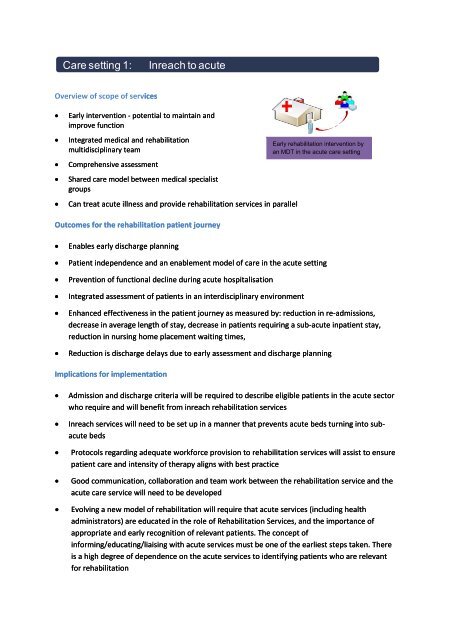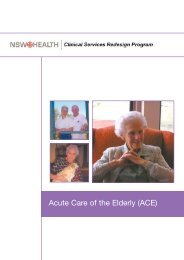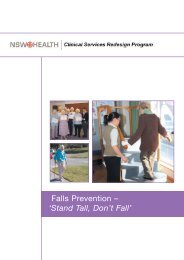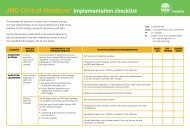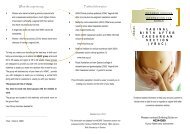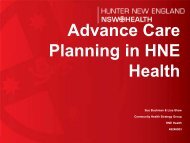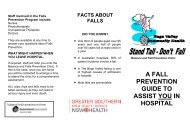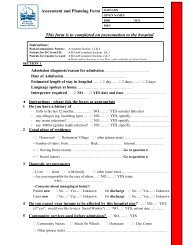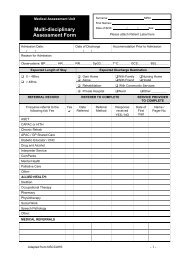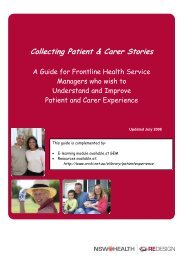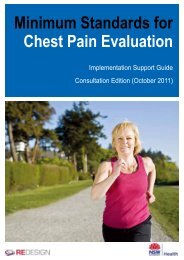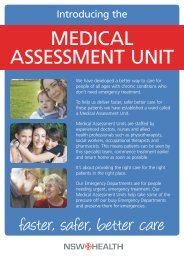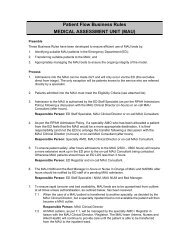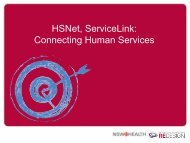Care setting 1: Inreach to acute ( pdf - 100 KB) - ARCHI
Care setting 1: Inreach to acute ( pdf - 100 KB) - ARCHI
Care setting 1: Inreach to acute ( pdf - 100 KB) - ARCHI
You also want an ePaper? Increase the reach of your titles
YUMPU automatically turns print PDFs into web optimized ePapers that Google loves.
<strong>Care</strong> <strong>setting</strong> 1: <strong>Inreach</strong> <strong>to</strong> <strong>acute</strong>Overview of scope of services• Early intervention ‐ potential <strong>to</strong> maintain andimprove function• Integrated medical and rehabilitationmultidisciplinary team• Comprehensive assessment• Shared care model between medical specialistgroups• Can treat <strong>acute</strong> illness and provide rehabilitation services in parallelOutcomes for the rehabilitation patient journey• Enables early discharge planningEarly rehabilitation intervention byan MDT in the <strong>acute</strong> care <strong>setting</strong>• Patient independence and an enablement model of care in the <strong>acute</strong> <strong>setting</strong>• Prevention of functional decline during <strong>acute</strong> hospitalisation• Integrated assessment of patients in an interdisciplinary environment• Enhanced effectiveness in the patient journey as measured by: reduction in re‐admissions,decrease in average length of stay, decrease in patients requiring a sub‐<strong>acute</strong> inpatient stay,reduction in nursing home placement waiting times,• Reduction is discharge delays due <strong>to</strong> early assessment and discharge planningImplications for implementation• Admission and discharge criteria will be required <strong>to</strong> describe eligible patients in the <strong>acute</strong> sec<strong>to</strong>rwho require and will benefit from inreach rehabilitation services• <strong>Inreach</strong> services will need <strong>to</strong> be set up in a manner that prevents <strong>acute</strong> beds turning in<strong>to</strong> sub<strong>acute</strong>beds• Pro<strong>to</strong>cols regarding adequate workforce provision <strong>to</strong> rehabilitation services will assist <strong>to</strong> ensurepatient care and intensity of therapy aligns with best practice• Good communication, collaboration and team work between the rehabilitation service and the<strong>acute</strong> care service will need <strong>to</strong> be developed• Evolving a new model of rehabilitation will require that <strong>acute</strong> services (including healthadministra<strong>to</strong>rs) are educated in the role of Rehabilitation Services, and the importance ofappropriate and early recognition of relevant patients. The concept ofinforming/educating/liaising with <strong>acute</strong> services must be one of the earliest steps taken. Thereis a high degree of dependence on the <strong>acute</strong> services <strong>to</strong> identifying patients who are relevantfor rehabilitation
• Integration and communication across NGO, State government, Federal government andprivate services <strong>to</strong> support continuity of care, for example through interdepartmental /agencypolicies and programs• The implementation of inreach services will involve collaboration and liaison with <strong>acute</strong> medicaland nursing staff and the provision of information and education for the <strong>acute</strong> care staff <strong>to</strong>enable the successful integration of an inreach serviceThe case studies below provide examples of how inreach models of rehabilitation care have beenimplemented.Case study 1: Acute care Rehabilitation TeamThe Acute care Rehabilitation Team (ART) at Wollongong Hospital aims <strong>to</strong> provide earlyrehabilitation <strong>to</strong> appropriate patient while they remain in the <strong>acute</strong> <strong>setting</strong>. The ART is astandalone team providing multidisciplinary rehabilitation input on a consultation liaisonbasis with ART patients in addition <strong>to</strong> standard therapy offered <strong>to</strong> patients on an <strong>acute</strong>ward. The program supports the philosophy that rehabilitation should be viewed as acontinuum that commences in <strong>acute</strong> care <strong>to</strong> prevent deconditioning that often results frombed rest and inactivity inherent in the <strong>acute</strong> hospital environment. The objective being thatimproving the functional status of patient s in the <strong>acute</strong> <strong>setting</strong> will lead <strong>to</strong> dischargedirectly from <strong>acute</strong> care where possible avoiding the need for a rehabilitation admission orleading <strong>to</strong> a shorter rehabilitation length of stay.Case study 2: The Acute <strong>Care</strong> of the Elderly (ACE) ModelThe Acute <strong>Care</strong> of the Elderly (ACE) Model is an agedcare initiative undertaken by Hornsby Ku-Ring-Gaihospital. ACE is a shared care arrangement between theadmitting Physician and a Geriatric Specialist, forpatients aged 65 years and over who are admitted <strong>to</strong>ED. The model of care is based on the admittingphysician working alongside the ACE team (whichincludes a geriatrician and a multi-disciplinary team)from day one of admission developing a comprehensivecare plan. The patient has one episode of care (ie thepatient is admitted from ED <strong>to</strong> the ACE ward andpreferable discharged from this ward) which improvescontinuum of care, reduces patient confusion andusually reduces the average length of stay. The focus ison maintaining function, encouraging activity andindependence through the <strong>acute</strong> phase of their illness.Evaluation of the ACE Model hasshown improved patien<strong>to</strong>utcomes:• Decreased re-admissionswithin 28 days for ACEpatients reduced from 12.4%-3%. Average cost saving for10 ACE patients NOT re 3%.• Less numbers of patientsrequire a stay within arehabilitation facility from theACE ward, prior <strong>to</strong> discharge• However, if an ACE patientdoes require rehab, theALOS = 11 days compared <strong>to</strong>a Non ACE patient ALOS =21 days.
Case study 3: Specialist Management with Acute Rehabilitation Treatment (SMART)Early commencement of rehabilitation in the <strong>acute</strong> phase. <strong>Care</strong> with a joint focus on <strong>acute</strong>care and active rehabilitation. Westmead is in the process of commissioning a newrehabilitation model of care and a SMART ward model – which involves early interventionin<strong>to</strong> orthopaedics, neurosurgery and trauma (the pilot is for 8 beds fully staffed with alliedhealth in the surgery ward). A risk stratification <strong>to</strong>ol will be utilised <strong>to</strong> identify patients onadmission who are at risk of loss of function whilst in hospital, have 3 or more comorbiditiesand would benefit from a rehabilitation approach. Patients enrolled in the pilotwill commence rehabilitation while under the management of their specialist surgical teaman in the surgical ward. It is proposed <strong>to</strong> build in<strong>to</strong> the project an evaluation of the SMARTservice <strong>to</strong> establish its potential impact on other hospitals and clinical specialties otherthan surgery. An evaluation plan will be developed in the first two months of projec<strong>to</strong>peration.Case study 4: Comprehensive Geriatric Medicine ServiceThrough the provision of a Comprehensive Geriatric Medicine Service at WestmeadHospital the above inreach programs are obviated by having such capacity inbuilt in<strong>to</strong> theoperational structure of the geriatric medicine services. The duality of inputs is replacedby having the attending physician skilled in both <strong>acute</strong> care and rehabilitation. The patientis admitted under the care of a geriatrician and associated interdisciplinary team. Thepatient undergoes a comprehensive assessment of their physical, psychosocial andfunctional needs. <strong>Care</strong> is focused on accurate diagnosis, optimising physiological andphysical function and development of comprehensive care plan under the auspices of theservice. There is a continuum of care provision through the <strong>acute</strong>, sub<strong>acute</strong> and noninpatient<strong>setting</strong>s as required


